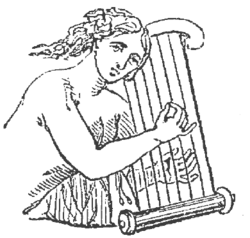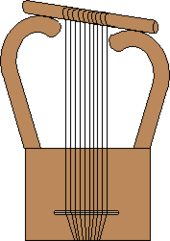|
The '''nevel''' or '''nebel''' ({{lang-he|נֵ֤בֶל}} ''nêḇel'') was a ] in use by the ancient ]. The Greeks referred to it as the ] (νάβλα, cf. Latin ''nabilium'').<ref>Rich, Anthony. ''A Dictionary of Roman and Greek Antiquities.'' New York: D. Appleton & Company. 1874. Page 439.</ref> Much conjecture has been put forth on its exact nature, but it was probably not a standardized instrument. Most hold it to be a form of ], or psaltery. The ] renders the word into English as ] or ], and the ] renders it ].<ref>Neil, James. ''Everyday Life in the Holy Land.'' London: Cassel & Company, Ltd. 1913. Page 218.</ref> The word ''nevel'' means harp in modern ]. |
|
The '''nevel''' or '''nebel''' ({{lang-he|נֵ֤בֶל}} ''nêḇel'') was a ] in use by the ancient ]. The Greeks referred to it as the ] (νάβλα, cf. Latin ''nabilium'').<ref>Rich, Anthony. ''A Dictionary of Roman and Greek Antiquities.'' New York: D. Appleton & Company. 1874. Page 439.</ref> A number of possibilities have been proposed, but most scholars believe the ''nevel'' was a harp.<ref name="Braun2002">{{cite book|author=Joachim Braun|title=Music in Ancient Israel/Palestine: Archaeological, Written, and Comparative Sources|url=https://books.google.com/books?id=AXrHi31KN9YC&pg=PA24|year=2002|publisher=Wm. B. Eerdmans Publishing|isbn=978-0-8028-4477-4|page=23}}</ref> The ] renders the word into English as ] or ], and the ] renders it ].<ref>Neil, James. ''Everyday Life in the Holy Land.'' London: Cassel & Company, Ltd. 1913. Page 218.</ref> The word ''nevel'' means harp in modern ]. |
 Ancient Nevel (Harp)
Ancient Nevel (Harp)
